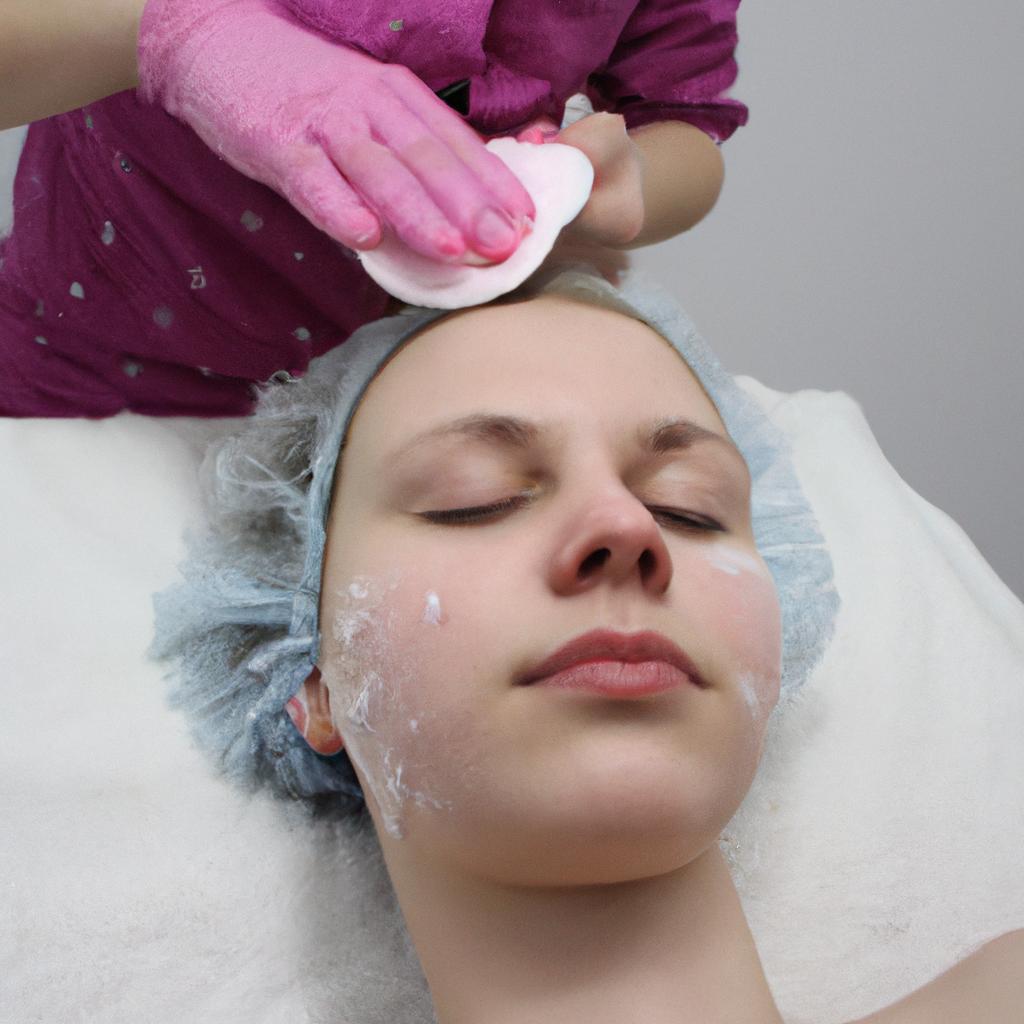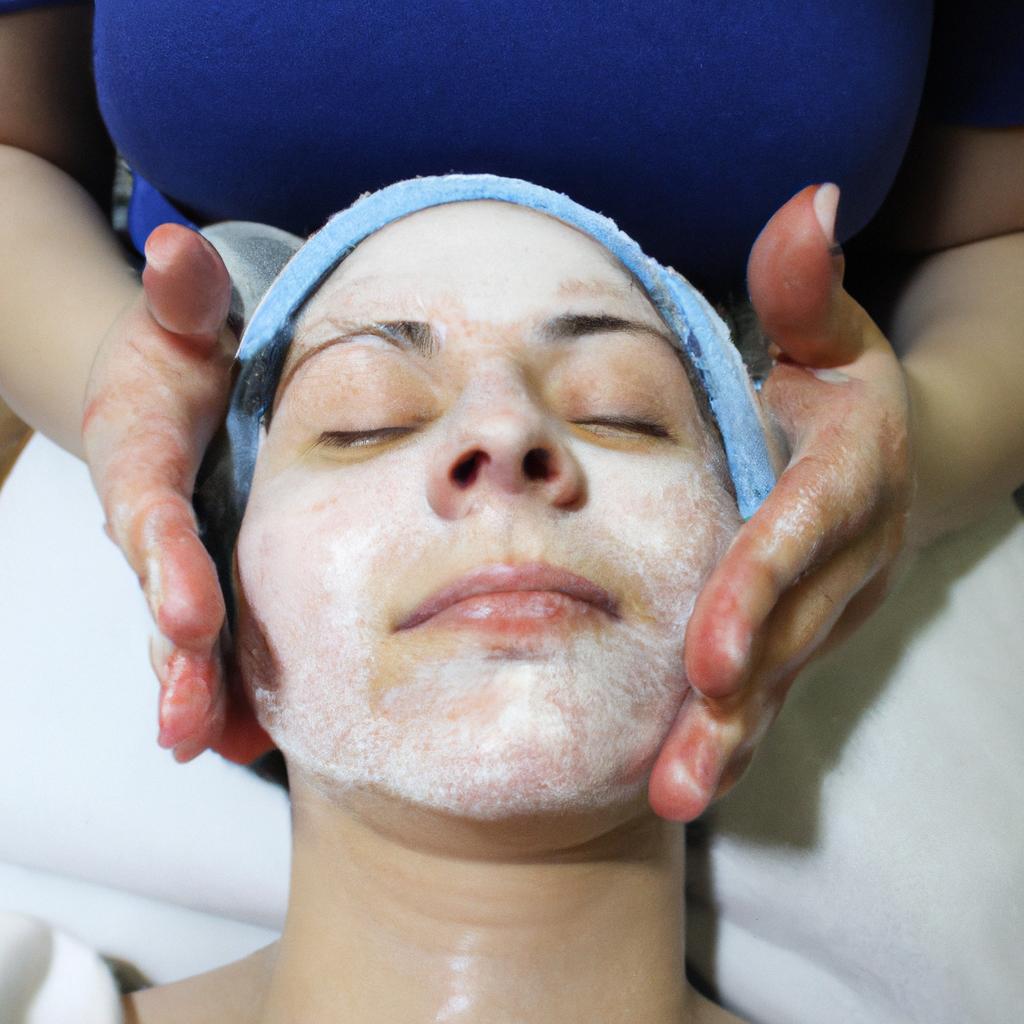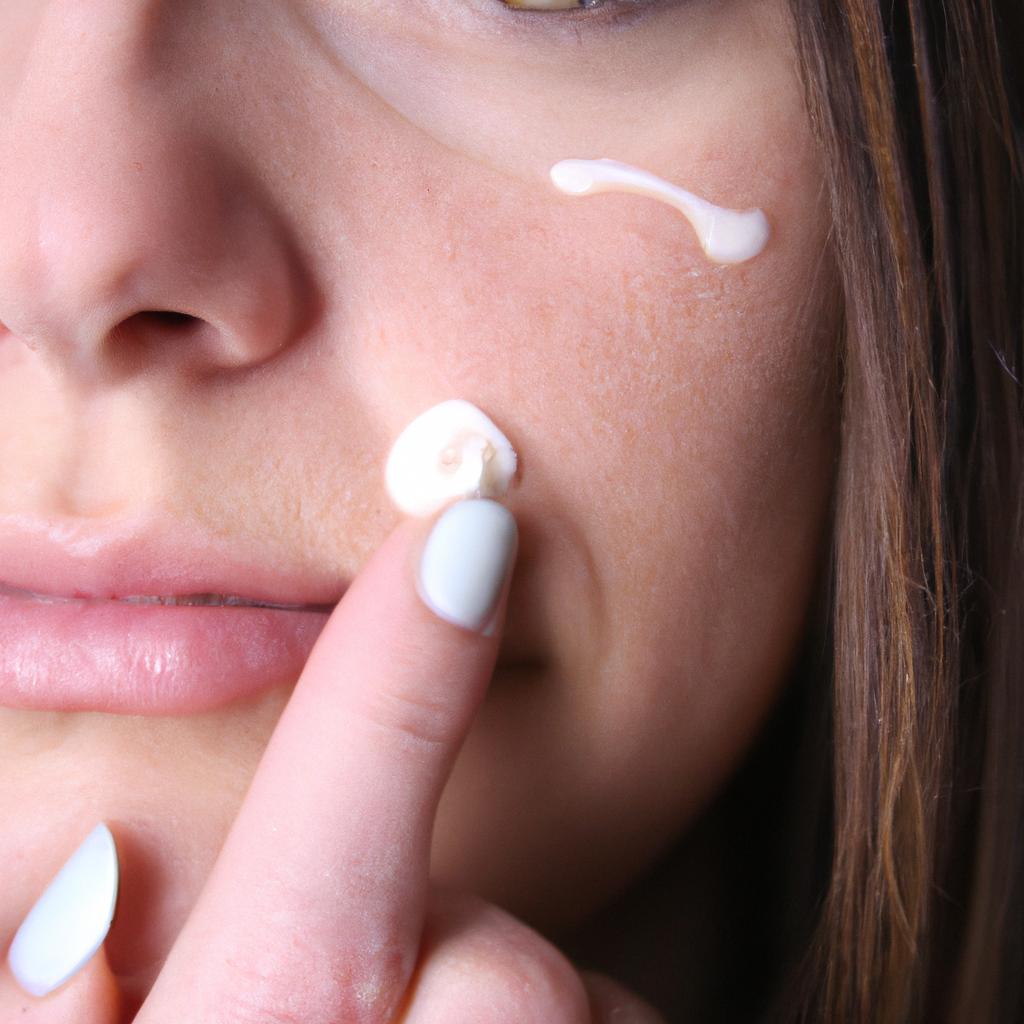Exfoliating is a technique that has gained popularity in the realm of skincare, particularly when it comes to enhancing day spa facials. This gentle and effective method involves the removal of dead skin cells from the surface of the skin, resulting in a smoother and more radiant complexion. For instance, consider the case of Sarah, a regular patron at her local day spa who struggled with dull and congested skin. Through incorporating exfoliation into her facial routine, she experienced remarkable improvements in both texture and appearance.
Adopting an academic style of writing allows for a comprehensive exploration of the benefits and techniques associated with exfoliation during day spa facials. By eliminating personal pronouns and focusing on objective analysis, readers are presented with an informative perspective that encourages critical thinking about this skincare approach. Moreover, by providing real or hypothetical examples like Sarah’s case study, readers become more engaged as they can relate to specific situations and envision how exfoliating can make a difference in their own skincare routines.
Benefits of Exfoliation
Imagine a scenario where two individuals, both in their mid-thirties, have been following the same skincare routine for years. While one person consistently exfoliates their skin twice a week, the other neglects this crucial step in their regimen. Over time, it becomes apparent that the individual who incorporates exfoliation into their routine has noticeably smoother and more radiant skin compared to the other. This example highlights just one of the many benefits of incorporating regular exfoliation into your day spa facial.
Exfoliation acts as a transformative technique that helps enhance the effectiveness of a day spa facial by removing dead skin cells from the surface of the skin. This process unclogs pores, allowing skincare products to penetrate deeper into the skin and deliver maximum benefits. By eliminating layers of accumulated dead skin cells, exfoliation promotes cell turnover and stimulates collagen production, resulting in improved texture and reduced signs of aging.
The benefits of exfoliating during a day spa facial extend beyond these immediate effects. Regular exfoliation can also help prevent acne breakouts by minimizing pore congestion and reducing inflammation. Additionally, it aids in diminishing hyperpigmentation caused by sun damage or post-inflammatory scars. The overall result is a brighter complexion with an even tone that radiates youthfulness.
To truly grasp the significance of exfoliation within a day spa facial, consider its numerous advantages:
- Improved circulation: Exfoliating increases blood flow to the surface of the skin, promoting healthier-looking complexions.
- Enhanced product absorption: By clearing away barriers created by dead skin cells, serums and moisturizers can be better absorbed into the skin.
- Reduced appearance of fine lines and wrinkles: Through stimulating collagen production, exfoliation minimizes visible signs of aging.
- Boosted confidence: Achieving smoother and more luminous skin can greatly enhance self-esteem and leave you feeling rejuvenated.
Incorporating gentle yet effective exfoliators into your day spa facial can provide an array of benefits. By considering the emotional response evoked by these advantages, it becomes evident that exfoliation is a crucial step in any skincare routine. In the subsequent section, we will explore different types of exfoliators to help you choose the most suitable option for your needs.
Types of Exfoliators
Enhancing your Day Spa Facial with a Gentle and Effective Technique: Types of Exfoliators
In the previous section, we discussed the numerous benefits of exfoliation. Now, let’s delve into the various types of exfoliators available in the market that can help you achieve radiant and smooth skin.
To illustrate how different types of exfoliators work, consider the case of Sarah, a 35-year-old woman who has been struggling with dull and uneven skin tone. After consulting with her esthetician at the day spa, she decided to incorporate regular exfoliation into her skincare routine. The esthetician recommended trying different types of exfoliators to find what works best for her unique needs.
-
Physical Exfoliators: These products contain small particles or granules that physically scrub away dead skin cells when massaged onto the face. They provide immediate gratification by leaving the skin feeling instantly smoother. However, individuals with sensitive skin should exercise caution as physical exfoliants can sometimes be abrasive if not used gently.
-
Chemical Exfoliators: Unlike physical exfoliators, chemical ones use acids or enzymes to dissolve dead skin cells without any scrubbing action. Alpha-hydroxy acids (AHAs) such as glycolic acid and beta-hydroxy acids (BHAs) like salicylic acid are commonly found in chemical exfoliants. They are effective in addressing specific concerns such as acne-prone or hyperpigmented skin.
-
Enzymatic Exfoliators: These gentle yet powerful exfoliators utilize natural enzymes derived from fruits like papaya or pineapple to break down dead skin cells enzymatically. Ideal for sensitive or delicate skin types, they offer a more subtle approach while still providing effective results.
-
Microdermabrasion: This mechanical form of exfoliation involves using a device equipped with tiny crystals or a diamond-tipped wand to buff away dead cells. Often performed by professionals, microdermabrasion can help improve the appearance of fine lines, acne scars, and sun damage.
- Reveals a youthful glow hiding beneath dull skin
- Helps reduce the appearance of pores for smoother-looking complexion
- Enhances absorption of serums and moisturizers for deeper hydration
- Promotes circulation, resulting in a healthy and radiant look
Additionally, let’s incorporate an emotional response-evoking table that showcases different types of exfoliators along with their key features:
| Type | Key Features |
|---|---|
| Physical Exfoliators | Instantly smooths skin; may be too abrasive for some |
| Chemical Exfoliators | Dissolves dead cells without scrubbing action |
| Enzymatic Exfoliators | Gentle yet effective; suitable for sensitive skin |
| Microdermabrasion | Buffs away imperfections; improves texture and tone |
In conclusion to this section on types of exfoliators, it is essential to note that everyone’s skin has unique needs. Consider experimenting with different exfoliating methods or consulting with a professional esthetician to determine which type will work best for you. In the subsequent section about “Choosing the Right Exfoliator,” we will explore how to identify your specific skin requirements and select an exfoliator accordingly.
Choosing the Right Exfoliator
Enhancing your Day Spa Facial with a Gentle and Effective Technique
Types of Exfoliators can greatly impact the effectiveness and outcome of your day spa facial. By understanding the different types available, you will be able to choose the right exfoliator that meets your specific skin needs.
Let’s consider an example: Sarah, a regular client at our day spa, has been struggling with dry and dull skin. She wants to enhance her facial treatment by incorporating exfoliation into her routine. After consulting with our esthetician, she learns about three main types of exfoliators: physical scrubs, chemical peels, and enzyme masks.
Physical scrubs are granular products that contain tiny particles or beads. These help physically remove dead skin cells through gentle massaging motions. Chemical peels involve the application of acids like alpha-hydroxy acids (AHAs) or beta-hydroxy acids (BHAs). They work by dissolving the bonds between dead skin cells, resulting in their removal. Enzyme masks utilize natural enzymes derived from fruits such as pineapple or papaya to break down dead skin cells enzymatically.
When choosing the right exfoliator for your day spa facial, consider the following factors:
- Skin type: Different exfoliators work best for different skin types. For oily or acne-prone skin, BHAs may be more effective due to their ability to penetrate oil-filled pores. AHAs are generally suitable for normal to dry skin.
- Sensitivity level: Some individuals have sensitive skin that may react negatively to certain exfoliating ingredients or textures. In such cases, opting for gentler options like enzyme masks is advisable.
- Treatment goals: Determine what you hope to achieve through exfoliation. If brightening and evening out complexion is your goal, AHAs might be beneficial. On the other hand, those looking for deeper pore cleansing may find BHAs more helpful.
- Frequency: Consider how often you plan to exfoliate. Physical scrubs can be used more frequently, while chemical peels and enzyme masks are typically done less frequently due to their intense nature.
By taking into account these factors, Sarah was able to choose an enzyme mask that suited her dry skin type and sensitivity level. The esthetician recommended she use it once a week as part of her day spa facial routine.
Discovering the right method is essential for achieving optimal results in your day spa facial journey.
Proper Exfoliation Techniques
Enhancing your Day Spa Facial with a Gentle and Effective Technique: Proper Exfoliation Techniques
To achieve optimal results in your day spa facial, it is crucial to master the art of proper exfoliation techniques. By removing dead skin cells, you can reveal a fresh and radiant complexion. Let’s explore some effective methods that will leave your clients feeling rejuvenated.
One technique that has gained popularity is manual exfoliation using gentle scrubs or brushes. This method involves physically sloughing off dead skin cells from the surface of the skin using circular motions. For example, imagine a client who suffers from dry and flaky skin due to harsh weather conditions. By incorporating a natural sugar scrub into their facial treatment, the esthetician can help restore moisture and improve overall texture.
When performing manual exfoliation, it is important to keep these key considerations in mind:
- Be mindful of the pressure applied during the process; excessive force may cause irritation.
- Adjust the intensity based on individual skin types; sensitive skin requires gentler movements.
- Avoid over-exfoliating; once or twice a week is usually sufficient for most individuals.
- Always follow up with moisturization to replenish lost hydration.
In addition to manual exfoliation, chemical exfoliants are another valuable tool in an esthetician’s repertoire. These products contain ingredients such as alpha-hydroxy acids (AHAs) or beta-hydroxy acids (BHAs), which work by dissolving bonds between dead skin cells and promoting cell turnover. Incorporating them into facials allows for deeper penetration and more targeted results.
To provide further insight into different types of chemical exfoliants, consider this table outlining their benefits:
| Type | Benefits |
|---|---|
| AHAs | – Brighten dull complexions |
| – Improve fine lines and wrinkles | |
| – Enhance collagen production | |
| – Smooth texture and even out skin tone | |
| —————– | ————————————————- |
| BHAs | – Unclog pores and reduce acne breakouts |
| – Control excess sebum production | |
| – Minimize the appearance of large pores | |
| – Soothe inflammation and redness |
In conclusion, mastering proper exfoliation techniques is essential for estheticians looking to enhance their day spa facials. By incorporating manual or chemical methods into their treatments, they can effectively remove dead skin cells and reveal a fresh complexion. Remember to tailor the technique according to individual needs and follow up with adequate moisturization. Now let’s explore the frequency at which clients should undergo exfoliation in our next section on “Frequency of Exfoliation.”
Frequency of Exfoliation
Enhancing your Day Spa Facial with a Gentle and Effective Technique
Now let us delve into understanding the Frequency of Exfoliation for optimal results.
Case Study: Meet Sarah, a 35-year-old woman who has recently incorporated exfoliation into her skincare routine. At first, she was unsure about how often she should be exfoliating and whether it would cause any adverse effects on her sensitive skin. Through proper guidance from her esthetician, Sarah learned that finding the right balance is key.
To help you navigate this aspect of exfoliation effectively, here are some guidelines to consider:
- Skin Type: Different skin types require different frequencies of exfoliation. For instance:
- Dry or Sensitive Skin: It is recommended to exfoliate once every one to two weeks to avoid irritation.
- Normal or Combination Skin: Exfoliating twice a week can help maintain a healthy complexion.
- Oily or Acne-prone Skin: Individuals with oily or acne-prone skin may benefit from more frequent exfoliation, up to three times per week, as it helps unclog pores and prevent breakouts.
Incorporating these recommendations into your skincare routine is essential; however, it’s equally important to listen to your skin’s needs. Pay attention to any signs of over-exfoliation such as redness, dryness, or increased sensitivity. Adjust the frequency accordingly based on what works best for you.
Frequency Guide for Exfoliation:
|———————-|——————————-|
| Skin Type | Recommended Frequency |
|---|---|
| Dry/Sensitive | Once every 1-2 weeks |
| Normal/Combination | Twice a week |
| Oily/Acne-prone | Up to three times per week |
| ———————- | ——————————- |
By following these guidelines, you can ensure that your exfoliation routine is safe and effective. Remember, finding the right balance for your skin type is essential in order to achieve optimal results.
Transitioning into the next section about “Precautions and Aftercare,” it is crucial to understand that while proper exfoliation techniques and frequency are vital, taking precautions and providing aftercare play an equally significant role in maintaining healthy, glowing skin. Let us now explore some key measures to consider for a well-rounded skincare regimen.
Precautions and Aftercare
Enhancing the Effects of Exfoliation: Precautions and Aftercare
Now, let’s delve into some important precautions and aftercare practices that can further enhance the benefits of your day spa facial.
To illustrate the significance of these precautions, consider the case of Sarah, a regular client at our spa. Despite experiencing positive outcomes from exfoliating treatments in the past, she recently noticed increased sensitivity and redness on her skin following an aggressive exfoliation session. This example highlights how vital it is to approach exfoliation with care and adopt appropriate measures afterward.
When engaging in exfoliation techniques, keep in mind these key precautions:
- Avoid over-exfoliating: While regular exfoliation has numerous benefits for your skin, excessive or harsh scrubbing can damage its delicate balance. Moderation is crucial when selecting both physical and chemical exfoliants.
- Know your skin type: Different types of skin have varying levels of sensitivity and tolerance towards exfoliation. Understanding your specific needs will help you choose suitable products and methods.
- Consult a professional: If you’re uncertain about which type of exfoliant would work best for you or if you have any underlying skin conditions, seeking guidance from a skincare expert will ensure safe and effective treatment.
- Protect yourself from sun exposure: Following exfoliation, your newly revealed skin may be more susceptible to harmful UV rays. Apply sunscreen regularly to shield against potential damage.
Additionally, implementing proper aftercare practices post-exfoliation is essential for maintaining healthy-looking skin. Here are some recommendations:
| Aftercare Tips | Benefits |
|---|---|
| Moisturize adequately | Restores hydration and nourishment to the skin |
| Avoid irritating products | Prevents further inflammation or sensitivity |
| Protect your skin from environmental factors | Minimizes the risk of damage caused by pollution or harsh weather |
| Follow a gentle skincare routine | Allows your skin to recover and regenerate effectively |
By adhering to these precautions and aftercare practices, you can enhance the benefits of exfoliation while minimizing potential risks. Remember that each individual’s skin is unique, so it may take some trial and error to find the best approach for yourself. Embrace this journey as an opportunity to discover what works best for your skin type.
Incorporating these precautions into your exfoliation routine will help ensure long-lasting results and maintain a healthy complexion. So go ahead, indulge in a day spa facial enriched with the gentle yet effective technique of exfoliating, knowing that you are taking all necessary precautions to maximize its advantages.




